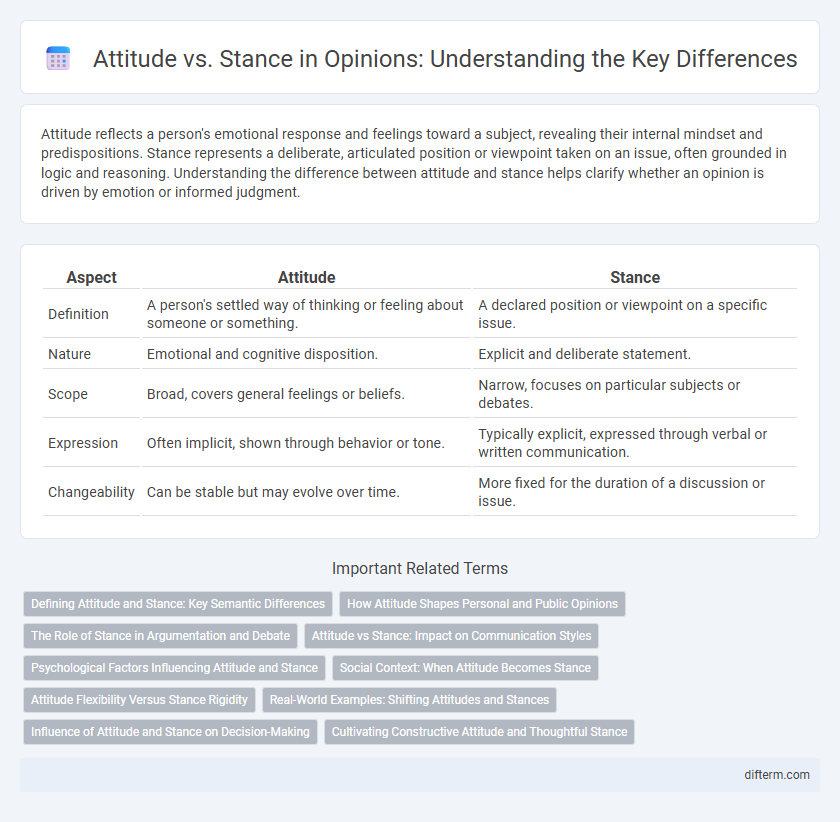Attitude reflects a person's emotional response and feelings toward a subject, revealing their internal mindset and predispositions. Stance represents a deliberate, articulated position or viewpoint taken on an issue, often grounded in logic and reasoning. Understanding the difference between attitude and stance helps clarify whether an opinion is driven by emotion or informed judgment.
Table of Comparison
| Aspect | Attitude | Stance |
|---|---|---|
| Definition | A person's settled way of thinking or feeling about someone or something. | A declared position or viewpoint on a specific issue. |
| Nature | Emotional and cognitive disposition. | Explicit and deliberate statement. |
| Scope | Broad, covers general feelings or beliefs. | Narrow, focuses on particular subjects or debates. |
| Expression | Often implicit, shown through behavior or tone. | Typically explicit, expressed through verbal or written communication. |
| Changeability | Can be stable but may evolve over time. | More fixed for the duration of a discussion or issue. |
Defining Attitude and Stance: Key Semantic Differences
Attitude refers to an individual's internal feelings or predispositions toward a subject, often shaped by emotions and personal experiences, while stance denotes a deliberate position or viewpoint expressed publicly or in discourse. Attitude is generally more subjective and affective, influencing behavior unconsciously, whereas stance is a conscious, strategic choice related to argumentation or persuasion. Understanding these semantic distinctions clarifies how people engage with topics internally versus how they present their perspectives externally.
How Attitude Shapes Personal and Public Opinions
Attitude serves as the underlying emotional and psychological foundation that shapes personal and public opinions by influencing how individuals interpret information and experiences. This internal predisposition determines the stance one adopts on various issues, guiding responses and behaviors in social and political contexts. Understanding the relationship between attitude and stance reveals the complexity behind opinion formation and the variability of public discourse.
The Role of Stance in Argumentation and Debate
Stance in argumentation serves as a clear position that guides the direction of debate, providing a foundation upon which arguments are constructed and evaluated. Unlike general attitudes, which are often subjective and fluid, stance offers a strategic framework that clarifies a debater's commitment to a specific claim or perspective. This clarity enhances persuasive effectiveness and helps interlocutors address core issues with precision.
Attitude vs Stance: Impact on Communication Styles
Attitude shapes the emotional tone and underlying feelings in communication, influencing openness and receptiveness, while stance reflects the explicit position or viewpoint that directs logical argumentation and decision-making. Distinguishing between attitude and stance is crucial for effective communication styles, as attitude affects relational dynamics and stance guides clarity and persuasion. Understanding this distinction enhances interpersonal interactions by balancing empathy with assertiveness in conveying messages.
Psychological Factors Influencing Attitude and Stance
Psychological factors such as cognitive dissonance, emotional experiences, and social identity significantly shape attitude and stance formation. Attitude often reflects underlying personal beliefs and values, while stance is more dynamic, influenced by situational cues and group norms. Understanding these psychological dimensions is crucial for predicting how individuals respond to conflicting information or social pressure.
Social Context: When Attitude Becomes Stance
Attitude transforms into stance in social contexts when personal feelings evolve into publicly expressed positions that influence group dynamics and social identity. This shift often occurs as individuals align their attitudes with collective values, solidifying their stance to advocate for specific social causes or beliefs. Understanding this progression helps clarify how private opinions contribute to broader social movements and cultural change.
Attitude Flexibility Versus Stance Rigidity
Attitude flexibility allows individuals to adapt their perspectives based on new information, promoting open-mindedness and nuanced understanding in complex situations. In contrast, stance rigidity often leads to fixed positions that can hinder constructive dialogue and problem-solving, as it resists change even when evidence suggests reconsideration. Balancing flexible attitudes with firm stances requires critical thinking and emotional intelligence to navigate social and intellectual challenges effectively.
Real-World Examples: Shifting Attitudes and Stances
Shifting attitudes and stances in real-world examples reveal how public opinion evolves in response to cultural, political, and social changes. For instance, the global perspective on climate change shifted from skepticism to urgent advocacy, reflecting a change in both individual attitudes and policy stances. This dynamic transformation underscores the difference between an attitude--personal feelings or beliefs--and a stance, which is a more formal position taken in public discourse or policy-making.
Influence of Attitude and Stance on Decision-Making
Attitude shapes decision-making by reflecting an individual's feelings and predispositions toward a subject, influencing choices subtly through personal bias and emotional response. Stance provides a clear, articulated position that guides decisions more directly, often based on rational evaluation and principles. Together, attitude and stance determine the complexity and clarity of decision outcomes, with attitude affecting internal motivation and stance impacting external justification.
Cultivating Constructive Attitude and Thoughtful Stance
Cultivating a constructive attitude involves embracing openness, empathy, and resilience to foster positive interactions and personal growth. A thoughtful stance requires critical reflection and informed judgment, enabling individuals to engage meaningfully with diverse perspectives. Balancing both elements leads to more effective communication and nuanced understanding in complex discussions.
attitude vs stance Infographic

 difterm.com
difterm.com